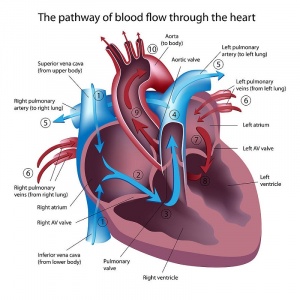Congestive Heart Failure - Pharmacotherapy
Introduction[edit | edit source]
Congestive Heart Failure (CHF) refers to the clinical syndrome caused by inherited or acquired abnormalities of heart structure and function, causing a constellation of symptoms and signs that lead to decreased quality and quantity of life.[1]See link for a comprehensive description.
Treatment involves a multidisciplinary team and incorporates lifestyle, allied health, pharmacological, and even surgical therapies, often specific to the underlying etiology. It incorporates pharmacotherapy, along side, treatment of comorbidities and complications (e.g. obesity, hypertension, depression) and lifestyle interventions (education, cessation of smoking and alcohol consumption, exercise therapy and improved diet). This article focuses on drug therapy.
Pharmacological Management of Heart Failure[edit | edit source]
Drugs used in heart failure include those used to initially manage mild to moderate failure and those used more commonly in severe to very severe conditions.
First Agents Used:
- ACE Inhibitors in the treatment of congestive heart failure
- Diuretics
- Glycosides and Congestive Heart Failure
- Beta-Blockers in the treatment of congestive heart failure (mild-to-moderate disease)
Additional Agents:
- More aggressive diuretic therapy
- Vasodilators
- parenteral inotropic agents (dobutamine)
Selection of agents and their combinations depend on initial clinical state and on patient responsiveness to initial therapy[2].
Medication[edit | edit source]
Beta-blockers, ACE inhibitors, glycosides, and diuretics are the key medications used for managing congestive heart failure through regulating renal function and the sympathetic nervous system. Adverse effects of these drugs are covered in the below links, providing implications of each drug in regards to physical therapy activity.
Beta-Blockers in the treatment of congestive heart failure[edit | edit source]
ACE Inhibitors in the treatment of congestive heart failure[edit | edit source]
Glycosides and Congestive Heart Failure[edit | edit source]
Aldosterone Receptor Antagonist Diuretics in the treatment of congestive heart failure[edit | edit source]
Patient Recommendations for Congestive Heart Failure[edit | edit source]
Conclusion[edit | edit source]
The prevalence and seriousness of CHF diagnosis warrant the dedication of physical therapists to continually develop the competencies needed to safely and effectively treat patients with this condition. Decreased tolerance for physical activity is a primary symptom of CHF with several implications for the physical therapist. As movement specialists, physical therapists utilize their knowledge and skills to prescribe exercise to meet a variety of patient goals. Consequently, a core component of physical therapy treatment is likely to be significantly influenced by the decreased movement capacity associated with CHF. Therapists must be astute in selection of exercise type and intensity to ensure a program that provides a sufficient stimulus but can be performed safely within the patient’s current abilities, without discouraging the patient or causing ill effect. Additionally, the status of a patient’s chief complaint must be considered in the context of their CHF diagnosis. Therapists will need to discern through clinical reasoning whether changes in function are likely due to physical therapy treatment or are being more heavily influenced by CHF and its associated sequelae and pharmacotherapy. Such an assessment is necessary to evaluate the effectiveness of a physical therapy program, communicate with other members of the patient’s healthcare team, and make requisite modifications.
As part of an interdisciplinary team, it is also essential that physical therapists be knowledgeable regarding the pharmacological treatment of CHF. The drugs used to manage CHF work by increasing cardiac contractility or decreasing cardiac workload. These pharmacological effects may potentially allow for drug therapy and exercise therapy to have the mutually reinforcing benefits of increasing exercise tolerance and strengthening cardiac function. Despite these potential benefits, the drugs used to treat CHF may also cause serious side effects including dizziness, nausea, arrhythmias, fatigue, and weakness. Knowledge of these side effects will allow the therapist to consider the response to exercise prescription and other modalities in the context of the patient’s pharmacotherapy. Early recognition of these symptoms may prevent development of serious complications or even death.
References[edit | edit source]
- ↑ Radiopedia CHF Available: https://radiopaedia.org/articles/congestive-cardiac-failure?lang=us(accessed 2.6.2021)
- ↑ Pharmacology 2020 Chapter 10: Pharmacological Management of Congestive Heart Failure Available:https://www.pharmacology2000.com/Cardio/CHF/chfobj1.htm (accessed 3.6.2021)
- ↑ Alila Medical Media Congestive Heart Failure: Left-sided vs Right-sided, Systolic vs Diastolic, Animation Available from: https://www.youtube.com/watch?v=b3OHSA7Tz7U (last accessed 16.6.2019)







